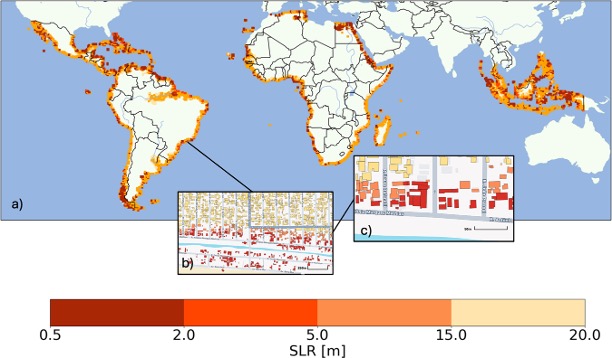Millions of Buildings Threatened by Rising Seas This Century, Study Warns – ScienceAlert

Report on Sea-Level Rise and its Impact on Sustainable Development in the Global South
Climate Change and the Threat to Global Sustainability Goals
A new study clarifies the significant threat that rising sea levels, a direct consequence of climate change, pose to the built environment in the Global South. This issue directly challenges the achievement of several Sustainable Development Goals (SDGs). The disruption of coastal infrastructure, including ports, jeopardizes global supply chains, impacting SDG 8 (Decent Work and Economic Growth) and SDG 2 (Zero Hunger) by threatening the globally interconnected economy and food systems. The findings underscore the urgent need for global commitment to SDG 13 (Climate Action), as rising seas will affect all nations, regardless of their proximity to coastlines.
Study Methodology and Scope
The research represents the first large-scale assessment to map individual buildings and their vulnerability to sea-level rise across key regions of the Global South. The methodology provides a framework for evidence-based policymaking in line with SDG 9 (Industry, Innovation, and Infrastructure) and SDG 17 (Partnerships for the Goals).
- Geographic Focus: Coastlines in Africa, Southeast Asia, and Central and South America.
- Technological Approach: Utilized innovations in remote sensing, machine learning, high-resolution topography, and building-footprint data.
- Data Scale: The study encompassed an analysis of 840 million buildings.
Key Findings and Projections
The study analyzed three scenarios of local sea-level rise, revealing a severe threat to human settlements and livelihoods, which are central to SDG 1 (No Poverty) and SDG 11 (Sustainable Cities and Communities). The projections represent minimum estimates, as they do not account for compounding factors like erosion, storm surges, or tidal intensification.
- 0.5-Meter Rise Scenario: This level is widely expected before 2100 even with ambitious CO2 emission reductions. It would result in the inundation of approximately 3 million buildings.
- 5-Meter Rise Scenario: This scenario would inundate about 45 million buildings, potentially eliminating over 80 percent of the building stock in some coastal nations.
- 20-Meter Rise Scenario: In this dire scenario, over 130 million buildings would likely be inundated by coastal flooding.
Implications for Sustainable Urban Development and Infrastructure
The findings have critical implications for urban planning and the resilience of communities. The concentration of vulnerable buildings in densely populated, low-lying areas presents a direct challenge to achieving SDG 11 (Sustainable Cities and Communities). The risk to ports and industrial districts also undermines progress on SDG 9 (Industry, Innovation, and Infrastructure). The study’s data and interactive map can serve as vital tools for policymakers to:
- Develop informed and sustainable land-use strategies.
- Guide the design of adaptive and resilient infrastructure.
- Facilitate difficult but necessary decisions regarding the potential relocation of communities away from high-risk coastal zones.
Conclusion and Call for Urgent Climate Action
With global sea levels currently rising at a rate of approximately 4.5 millimeters per year, a moderate amount of sea-level rise is now unavoidable. The report concludes that immediate and comprehensive planning is essential for coastal communities to adapt and maintain their viability. This requires a dual approach: localized adaptation strategies to build resilience and a strengthened global commitment to SDG 13 (Climate Action) to mitigate the long-term drivers of sea-level rise by ceasing the burning of fossil fuels. The sooner communities begin planning, the greater their capacity to flourish amidst these environmental changes.
Analysis of Sustainable Development Goals in the Article
1. Which SDGs are addressed or connected to the issues highlighted in the article?
-
SDG 1: No Poverty
The article focuses on the Global South, where vulnerability to climate change can exacerbate poverty. The loss of homes, livelihoods, and essential infrastructure due to rising sea levels directly threatens the economic stability of millions, pushing them further into poverty.
-
SDG 9: Industry, Innovation and Infrastructure
The text explicitly mentions the threat to “vital infrastructure,” “ports,” and millions of buildings. It highlights the vulnerability of the built environment, which is central to economic activity and societal well-being, connecting directly to the need for resilient infrastructure.
-
SDG 11: Sustainable Cities and Communities
The core issue discussed is the threat that rising sea levels pose to coastal communities and urban areas. The article discusses the vulnerability of “bustling conurbations,” the need for better urban planning, and the potential relocation of entire communities, all of which are key concerns of SDG 11.
-
SDG 13: Climate Action
This is the most central SDG. The article’s entire premise is based on the consequences of climate change, specifically sea-level rise caused by global warming from burning fossil fuels. It discusses the need for adaptation, resilience, and planning in response to climate-related hazards.
2. What specific targets under those SDGs can be identified based on the article’s content?
-
SDG 1: No Poverty
- Target 1.5: “By 2030, build the resilience of the poor and those in vulnerable situations and reduce their exposure and vulnerability to climate-related extreme events and other economic, social and environmental shocks and disasters.” The article’s focus on mapping building vulnerability in the Global South is a direct effort to understand and ultimately reduce the exposure of vulnerable populations to the disaster of sea-level rise.
-
SDG 9: Industry, Innovation and Infrastructure
- Target 9.1: “Develop quality, reliable, sustainable and resilient infrastructure… to support economic development and human well-being.” The article underscores the lack of resilience in existing coastal infrastructure (“ports and coastal infrastructure exposed to sea-level rise”) and the potential for disruption to the “globally interconnected economy,” aligning with the goal of building more resilient infrastructure.
-
SDG 11: Sustainable Cities and Communities
- Target 11.5: “By 2030, significantly reduce the number of deaths and the number of people affected and substantially decrease the direct economic losses… caused by disasters, including water-related disasters…” The study quantifies the number of buildings and, by extension, people who will be affected by the water-related disaster of coastal inundation, directly addressing the core of this target.
- Target 11.b: “…increase the number of cities and human settlements adopting and implementing integrated policies and plans towards… adaptation to climate change, resilience to disasters…” The article states that studies like the one discussed can “help urban planners minimize risks” and “inform new land-use strategies and adaptive designs,” which speaks directly to the implementation of plans for climate adaptation and disaster resilience.
-
SDG 13: Climate Action
- Target 13.1: “Strengthen resilience and adaptive capacity to climate-related hazards and natural disasters in all countries.” The entire article is about understanding the risks of a specific climate-related hazard (sea-level rise) to strengthen resilience. The creation of an “interactive map identifying areas of greatest risk” is a tool to build adaptive capacity.
3. Are there any indicators mentioned or implied in the article that can be used to measure progress towards the identified targets?
-
Directly Mentioned Indicators:
- Number of buildings at risk of inundation: The article provides specific figures: “roughly 3 million buildings would be inundated” with a 0.5-meter rise, and “about 45 million buildings” with a 5-meter rise. This serves as a direct indicator for measuring exposure and potential economic loss under Target 11.5.
- Rate of sea-level rise: The article states that “global sea levels are now rising by about 4.5 millimeters per year.” This is a key physical science indicator that tracks the progression of the climate hazard itself, relevant to SDG 13.
-
Implied Indicators:
- Number of people affected by sea-level rise: The article mentions that “close to 750 million people, live within 5 kilometers of the shoreline,” implying that the number of people living in low-lying coastal zones is a key indicator of vulnerability (relevant to Target 1.5 and 11.5).
- Proportion of infrastructure vulnerable to climate change: The study’s methodology of mapping individual buildings against sea-level rise scenarios implies an indicator related to the proportion of critical infrastructure (buildings, ports) located in disaster-prone coastal areas (relevant to Target 9.1).
- Adoption of land-use strategies for climate adaptation: The article suggests the study’s findings can “inform new land-use strategies and adaptive designs.” The existence and implementation of such strategies in coastal cities would be an indicator of progress towards Target 11.b.
4. Summary Table of SDGs, Targets, and Indicators
| SDGs | Targets | Indicators |
|---|---|---|
| SDG 1: No Poverty | 1.5: Build resilience of the poor and reduce their exposure and vulnerability to climate-related disasters. | Number of people living in low-lying coastal zones (Implied by the figure of 750 million people living within 5km of the shoreline). |
| SDG 9: Industry, Innovation and Infrastructure | 9.1: Develop quality, reliable, sustainable and resilient infrastructure. | Proportion of critical infrastructure (e.g., ports, buildings) vulnerable to sea-level rise (Implied by the study’s mapping of buildings at risk). |
| SDG 11: Sustainable Cities and Communities | 11.5: Significantly reduce the number of people affected and economic losses from water-related disasters.
11.b: Increase the number of cities implementing policies for climate change adaptation and disaster resilience. |
Number of buildings at risk of inundation under different scenarios (e.g., 3 million buildings at 0.5m rise) (Directly mentioned).
Adoption of adaptive land-use strategies in coastal communities (Implied by the article’s suggestion that the study can inform such strategies). |
| SDG 13: Climate Action | 13.1: Strengthen resilience and adaptive capacity to climate-related hazards. | Rate of global sea-level rise (Directly mentioned as 4.5 mm per year).
Availability of risk-mapping tools for adaptation planning (Implied by the creation of the study’s interactive map). |
Source: sciencealert.com
What is Your Reaction?
 Like
0
Like
0
 Dislike
0
Dislike
0
 Love
0
Love
0
 Funny
0
Funny
0
 Angry
0
Angry
0
 Sad
0
Sad
0
 Wow
0
Wow
0
















































/environment-climate-change-and-health-(ech)/water-sanitation-hygiene-and-health-(wsh)/landfill-tuvalu-36092.tmb-1200v.jpg?sfvrsn=5c21fe40_1#)

.jpg.webp?itok=0ZsAnae9#)

























